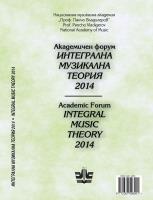Взаимодействие на класическа и съвременна хармония в хроматиката
Interaction between Classical and Modern Harmony in Chromaticism
Methodological and Historical Aspect
Author(s): Andrey DiamandievSubject(s): Social Sciences, Education, Fine Arts / Performing Arts, Music, History of Art
Published by: Издателство НМА „Проф. Панчо Владигеров”
Summary/Abstract: The interaction between classical and modern harmony is seen from a methodological aspect as a systematic and structural category, namely as a tone system that more or less destroys tonality, and from a historical aspect – the time when that happened, namely at the end of the nineteenth century and approximately by the end of the mid-twentieth century. During that period, we can find out a number 75 of ‘border’ examples representing the opposite poles between the so-called classical and modern harmony, where tonality can be perceived in an atonal environment and vice versa – it can be an environment in a context beyond its borders in the works of composers as Brahms, Wagner, Wolf, Bruckner, Mahler, Reger, Strauss, Schönberg, Berg, Webern, Debussy, Bartok, Shostakovich. We can find such occurrences earlier by composers such as Mozart, Beethoven and Schubert. Such a process is technologically and structurally implemented mostly in chromaticism, which should be seen simultaneously, not separately, in the two types of harmony. Such an approach is suggested by the author as a new aspect in the teaching methods of the subject of Harmony in Bulgaria.
Journal: Академичен форум »Интегрална музикална теория«
- Issue Year: 2015
- Issue No: 1
- Page Range: 68-75
- Page Count: 8
- Language: Bulgarian

